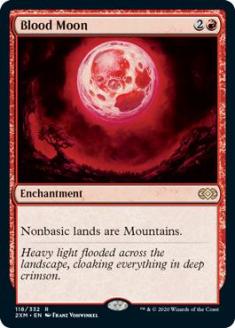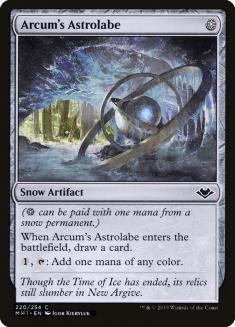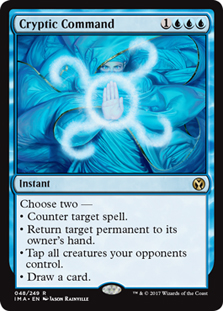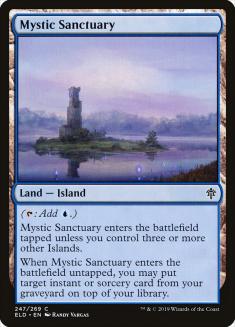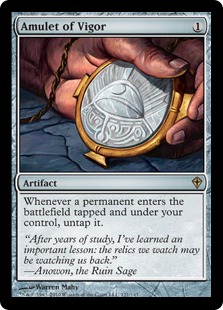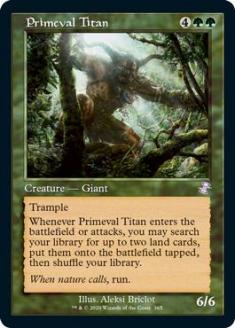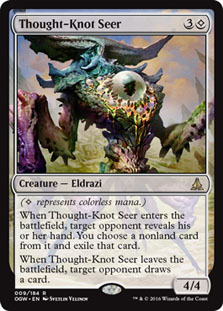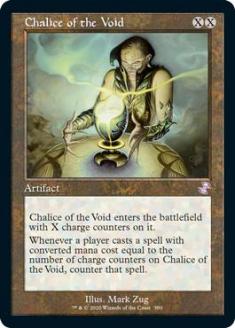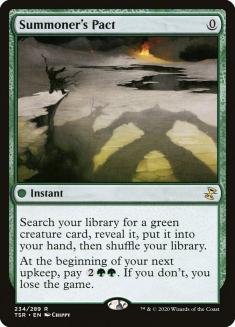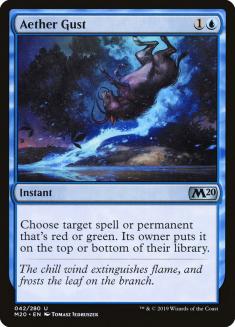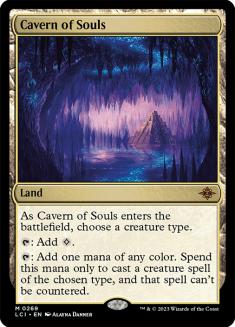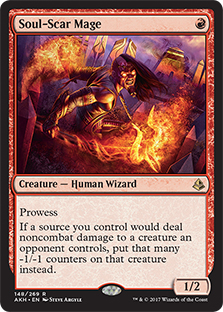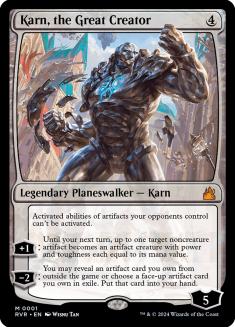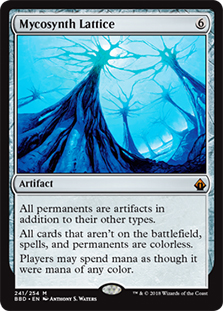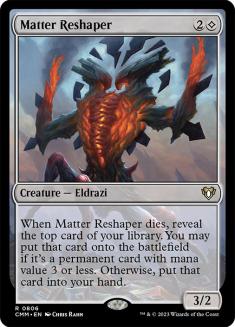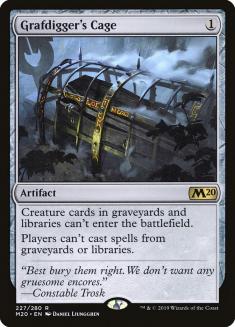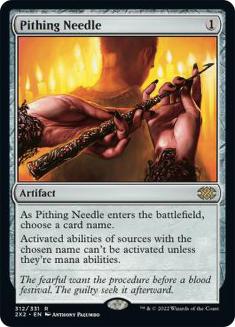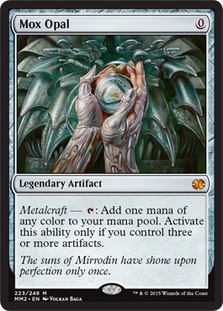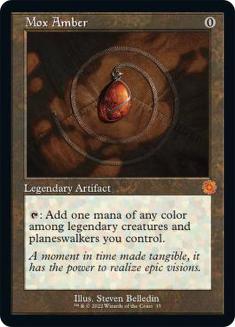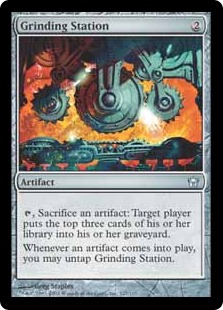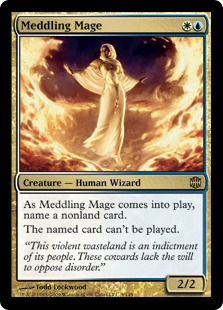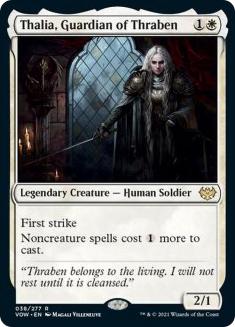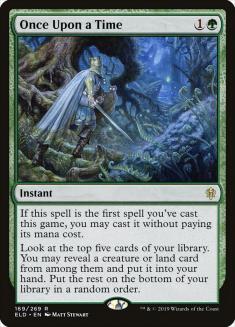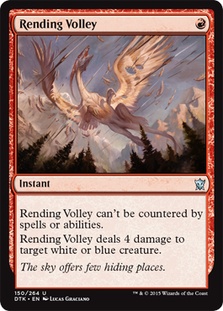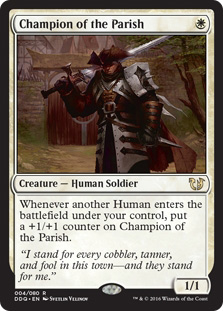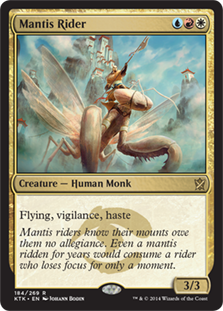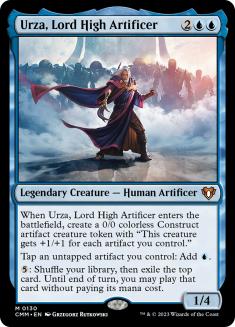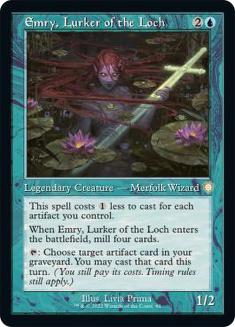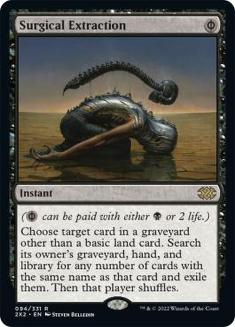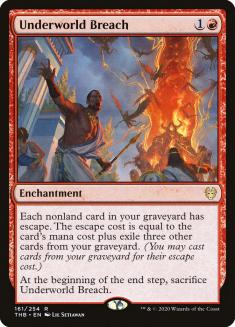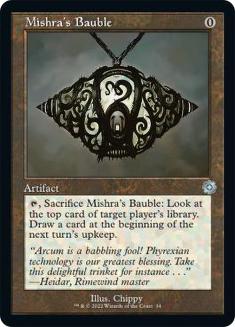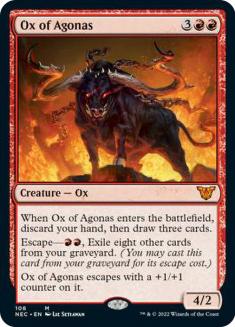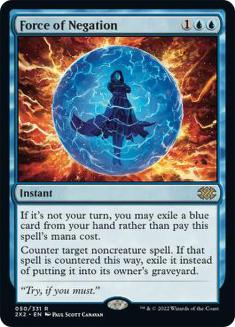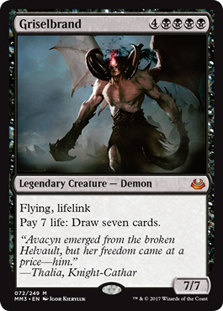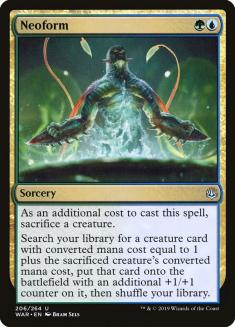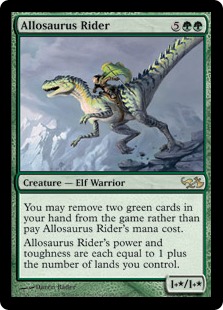Since the Mox Opal and Faithless Looting bans, Modern has become a vastly different format. Only now that some of the Throne of Eldraine issues are cleared up are we starting to see the format really adjust to that, and in turn how decks and sideboards react is just catching up to that wave of new top decks.
These are the cards you should be paying attention to. These are the new hate card standouts of Modern.
1. Blood Moon
It might seem obvious that Blood Moon is good in Modern, but that isn’t the entire story.
Blood Moon used to be a successful standalone strategy, but since Modern Horizons it hasn’t been the same. Arcum’s Astrolabe is solidly in the category of design mistakes, breaking down color and synergy barriers way too easily, and it makes Blood Moon a joke. Not only does it negate Blood Moon’s impact on color fixing, Arcum’s Astrolabe comes alongside larger snow-covered basic land counts. The odds of catching your opponent on all nonbasics even in the non-Astrolabe games is basically zero, especially when they preemptively fetch their basics in anticipation of drawing Astrolabe later.
It might seem like Blood Moon can serve a purpose against the secondary Mystic Sanctuary plan of a lot of these Arcum’s Astrolabe decks, but Cryptic Command makes that difficult. By sitting around on a Blood Moon, you’re setting yourself for a natural lock break where your opponent builds up Snow-Covered Islands and Arcum’s Astrolabe and Mountain-ed fetchlands, bounces your Blood Moon with Cryptic Command in the end step, and immediately has the fetch to Mystic Sanctuary to recur Cryptic Command and counter your three-mana enchantment on the way back down.
But Blood Moon is still a super-effective hate card.
I’ve written a lot over the years about how the Modern hate cards line up with the various Modern decks within the macro-strategies the format offers. The consistent trend is that you often have a ton of options that look like they should be similarly effective against similar strategies, but in practice having the exact right effect is matchup-defining.
Blood Moon is the premier hate card against Amulet Titan. All of the individual land destruction just doesn’t cut it. You’re assuming they won’t draw Sakura-Tribe Scout with a bounceland, they won’t just draw more lands in their 30-land deck, or that you can somehow handle their entire deck except one end-game land. Blood Moon just cuts it all off, leaving you with the simple goals of “beat Colossal Dreadmaw” and “don’t let Blood Moon die.”
But the real win for Blood Moon is also being the most effective land hate against Eldrazi Tron. All of the individual land hate against Eldrazi Tron has this unfortunate habit of landing after they resolve Thought-Knot Seer or another early threat. Even if they stick one threat, Blood Moon makes it really hard for them to land another one. Where traditional Mono-Green Tron can break out with a high land count and color-fixing cantrips like Chromatic Star, Eldrazi Tron needs its colorless mana and doesn’t have a ton of Wastes to work with.
Blood Moon as a maindeck plan isn’t where Modern is right now, but it and the almost-equivalent Magus of the Moon are among the best sideboard cards in the format.
2. Chalice of the Void
On the note of Eldrazi Tron, the proper application of Chalice of the Void remains one of its best aspects.
While Chalice of the Void might historically be more associated with X=1, the Chalice on zero option is currently the reason it is so effective in Modern. The latest spike in Underworld Breach combo relies on casting zero-cost artifacts from the graveyard repeatedly, and even if Chalice of the Void isn’t a hard lock, it is a free-to-cast hurdle they must overcome. It also eventually represents a later threat of Chalice on two, making the combo very hard to assemble, meaning multiple Chalices are good even if that deck’s best answer is the three-cost Teferi, Time Raveler. Notably the current Underworld Breach lists don’t play a ton of colorless mana sources, meaning the traditional answer of Engineered Explosives with zero sunburst but a nonzero mana cost isn’t a reliable breakout plan.
But just like Blood Moon, the secret to Chalice of the Void’s success is being multifaceted. Eldrazi Tron leverages the combination of Chalice of the Void covering Summoner’s Pact and Thought-Knot Seer covering the actual creature to have a solid Amulet Titan matchup. I can easily see a Thoughtseize deck using Chalice of the Void to similar effect.
A free lock piece is really something else, and now you can start to see why Chalice is an obvious restriction in Vintage.
3. Aether Gust
Continuing along the big mana axis, Aether Gust is a huge part of Amulet Titan sideboards. You don’t see a ton of Fry, Noxious Grasp, or Devout Decree in Modern, so why is the blue part of the Core Set 2020 hate card cycle seeing notable play?
The obvious upside for Amulet Titan is Aether Gust as an answer to Blood Moon, as well an answer for all the land destruction that is worse than Blood Moon. You do need to target the Blood Moon on the stack, though, as even if you control a Dryad of the Ilysian Grove, which effect ends up mattering is based on timestamps. If you have a Forest, you can cast Dryad after Blood Moon and fire off Aether Gust, but if you have a basic land, you could cast a different answer anyway.
The less obvious upside is acting as an anti-uncounterable counterspell. Even if your opponent has Cavern of Souls, Aether Gust puts their Primeval Titan right back into their library. The same applies to dodging Veil of Summer. If you just need that one extra turn to execute your kill, Aether Gust is a great piece of interaction.
Aether Gust is also a solid option against Mono-Red Prowess. The key to beating that deck is managing their creatures, and when you Aether Gust something after they commit prowess triggers to it, the end effect is basically the same as a hard removal spell. A similar but lesser pattern also applies to Infect, where you can hit their pump spell even against the nongreen threats.
If you’re playing any similar deck, where you can turn up a win on a dime but want a bit of good interaction that still works if you tap out, consider Aether Gust for the spot. Bonus points if the cards you’re afraid of might be red, like Anger of the Gods.
4. Karn, the Great Creator
Is Karn, the Great Creator really a hate card? Well, it isn’t “a” hate card. It is all of the hate cards.
My opinion on Karn, the Great Creator has oddly flipped since the January bans.
In the Mycosynth Lattice era, Karn was overplayed. Protecting Karn mattered a lot since it needed to remain on the battlefield to maintain the Mycosynth Lattice lock, and many decks playing Karn were horrible at that. They aimed to ramp to Karn with creatures that were chump blockers at best, and that could easily lead to a useless Mycosynth Lattice on the battlefield and no planeswalker to make it matter.
Put simply, Matter Reshaper was only a playable card because Karn demanded it. And that is stretching the word “playable.”
Now Karn, the Great Creator is about finding a card that doesn’t need Karn to function as a lock. People also aren’t as aggressive, with the fast kill decks being things that don’t produce Prized Amalgams or other bodies that pressure Karn the way they used to. All of the decks that were previously bad Karn decks now are in the clear to ramp into a way to select the right hate card.
Of course, Karn itself is a hate card for artifacts. Even if the banning of Mox Opal means there are fewer decks that fold to a Stony Silence effect, Underworld Breach is notably soft to it. How can you activate Grinding Station through a Karn, the Great Creator? Are you going to Teferi, Time Raveler that one?
5. Meddling Mage
To start, people should just be playing Humans more.
Look at these Amulet Titan lists. Back in the day, people were adding a bunch of copies of Walking Ballista or even Dragonlord Atarka to their Amulet Titan decks in order to beat Humans and Meddling Mage. They just don’t have that now. Sure, they have a much more reliable Turn 3.5 Primeval Titan, but that involves being able to literally cast the card Primeval Titan.
And has any combo deck ever beat Humans? Why would Underworld Breach be an exception? Engineered Explosives at best gets you near a coin flip, no more.
If you can build a reasonable Once Upon a Time Humans list, congratulations, you broke it. I’m really not sure it’s possible, but if it is that’s a clear winner.
But if you remember earlier, I did mention Chalice of the Void along with Thoughtseize. What about Chalice of the Void with Meddling Mage? There aren’t a ton of decks whose mana includes easy Azorius access these days, but Meddling Mage is a good way to diversify your hate cards in the face of counter-hate.
6. Rending Volley
Meddling Mage brings us right into our next hate card: Rending Volley.
Rending Volley is really good against Humans. It kills the small stuff that attacks. It kills the hatebears, especially with Kitesail Freebooter being identified as a negotiable slot. It kills the larger attackers, keeping Humans on the ground without Mantis Rider.
But the important secondary use of Rending Volley is clearing blue artifact enablers. The latest Dimir Whirza lists are just playing Urza, Lord High Artificer, but Rending Volley becomes a great sideboard option if they ever go back to playing Emry, Lurker of the Loch. The problem with playing reactively against both cards is that they’re so mana-efficient and provide some inherent value, and having a one-cost unstoppable answer to both helps a lot with that.
Efficiency matters in both cases. It might seem you can catch more overlap with a lucky copy of Jace, the Mind Sculptor with a Fry, but in practice the extra mana eats into your ability to pressure the Urza deck or keep up with Humans. Remember: Dimir Whirza is really a soft control deck with an efficient finisher and a combo end-game. It isn’t an artifact combo deck you shatter with a single piece of interaction. Fry is playing the sit-back-and-wait game against a strong value deck; Rending Volley is more easily slotting in the quick answer to their best card and moving on with clean curve-out pressure.
This is the most speculative card on this list. Rending Volley isn’t quite the perfect card for this moment in Modern, but the signs all point to it being an important player and the most efficient option moving forward.
7. Surgical Extraction
On the subject of efficiency, nothing really matches Surgical Extraction.
And Underworld Breach really forces that efficiency. Given time, they can play around nearly every hate card. That time is often just casting Teferi, Time Raveler or casting Underworld Breach to recast Teferi, Time Raveler. Surgical Extraction lets you play all your other cards and force them to race to go off right into interaction. It’s also extremely punishing to a value Underworld Breach turn or protracted Grinding Station self-mill setups, forcing your opponent further down the racing line.
Why Surgical Extraction over the equally free Tormod’s Crypt? Surgical Extraction has broader uses against any combo deck you want to interact with, but also Dredge is softer to Surgical Extraction than ever before. The loss of Faithless Looting left Dredge as a less sticky deck. When they fire their early enabler, that’s about it. They might be able to Shriekhorn into an Ox of Agonas and go off again later, but that’s mostly luck and not flashback Faithless Looting. Surgical Extraction as a roadblock is more effective than ever. Similarly, Dredge is able to explode less after their initial big dredge. If you cut a key creature hit on that first big flip with Surgical Extraction they are far from assured to be able to find the pressure they need to close. Dredge also can’t proactively answer Surgical Extraction the same way they can destroy Tormod’s Crypt with a catchall Abrupt Decay.
The difference between the point exile and the mass exile is as small as it has ever been, so why not take the other benefits too?
8. Force of Negation
Force of Negation was basically everywhere when Modern Horizons was released and stayed that way through the unbanning of Stoneforge Mystic. Now where are the blue decks packing the card? With Primeval Titan as the face of combo, everyone has cut the card for other interaction.
But monsters still lurk deep in the format, and Primeval Titan isn’t the only Summoner’s Pact deck I recommended Chalice of the Void for. Neobrand is realer and scarier than it ever was last year. Neobrand isn’t just its reputation as Turn 1 or bust, it has a lot of slightly slower kills that play out much better in a format without Faithless Looting or Mox Opal to race.
With Underworld Breach making spell-based combo a threat again, you might do well to have some cheap or free counterspells in your deck. You never know when you might get paired against some Turn 1 maniac.



